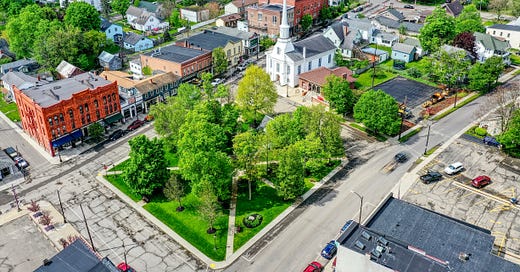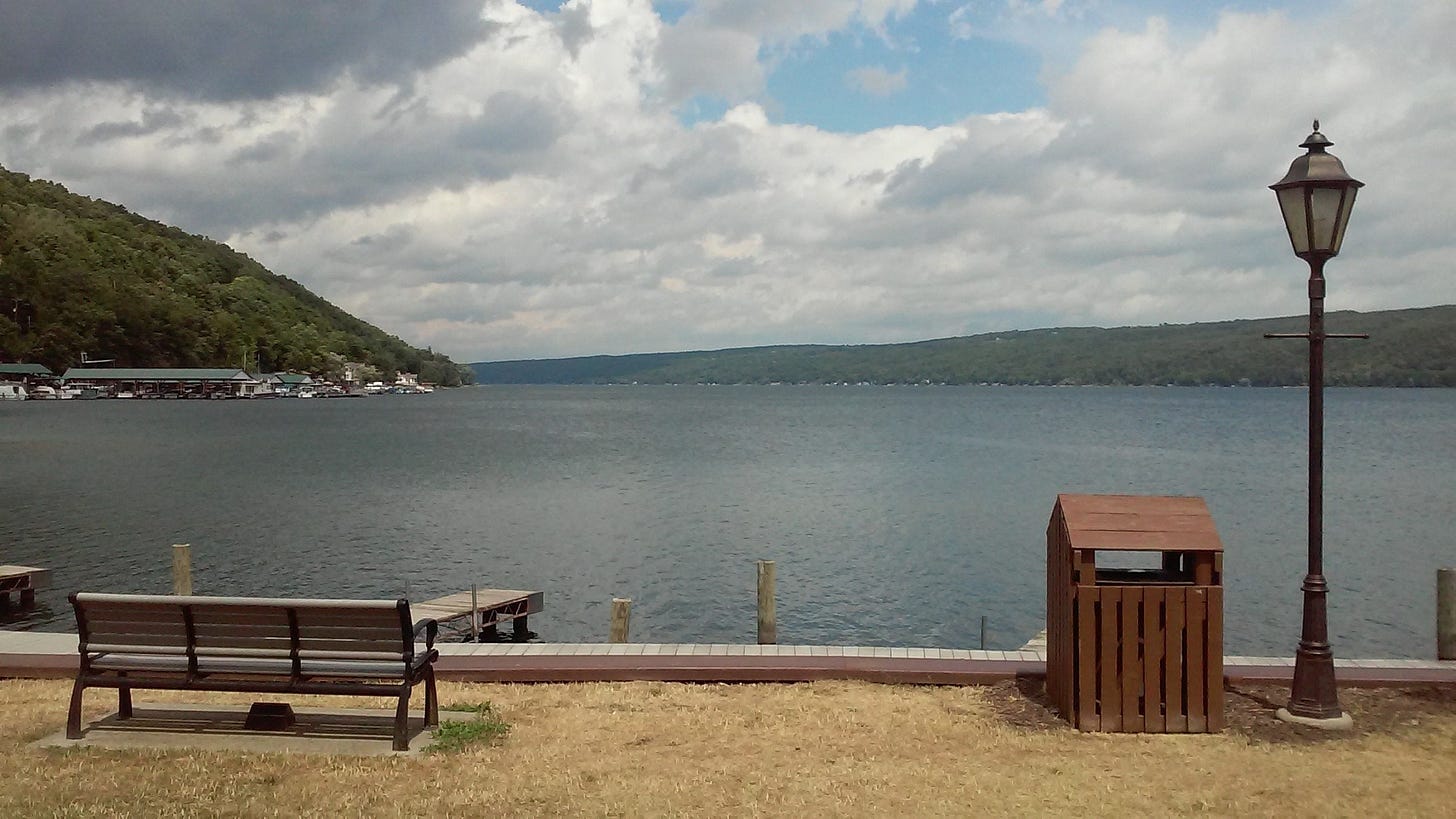I Was a Walker.
I was a walker. Not in the contemporary zombie or wight-like sense of the word. I walked to school.
I grew up in Hammondsport, a small town in the Finger Lakes region of Upstate New York. It was one of those places that I couldn't wait to leave as a kid, but as an adult I’d like nothing better than to figure out a way to live there permanently.
In 1980, which is the period of reference for this post, the US census bureau reports a population in Hammondsport of about 1,000 people (although as the of 2020 census that population had fallen to about half that number).
There were two schools in Hammondsport at the time, the Main Street school and the Curtiss School. The Main street school was the big, modern school, built in 1957. Grades kindergarten through three and seven through twelve went there. Grades four through six (and one third grade class) went to the much smaller and older Curtiss school. I was one of those selected for the sole third grade class at the Curtiss School, meaning I spent four years there instead of just three.
The Main Street School was literally within sight of my family home back then. In fact, It probably takes longer to walk to my office from my assigned parking lot at my current employer than it took to walk to the school. The Curtiss School, on the other hand, was up on the other end of town, probably a 10 or 15 minute walk.
It’s also important to note that, by the time I started attending the Curtiss School, my parents had divorced. Both of them worked as well, so I was on my own both before and after school. A latch-key kid, as were many of my friends at the time.
I don’t remember the exact year I began to walk to school every day. My third grade year would have started in the Fall of 1978, and I would have been 8 years old at that time. Back then, though, in that small town, where literally everybody knew who you were and who you belonged to, it would'n’t have been a stretch to see an 8 year-old walking back and forth from school. In a small town like that, people looked out for each other, and kids were always in a kind of protective bubble, watched over by all the adults during their comings and goings. There was also, at that time, no access to the 24 hour news cycle, with all its reports of murders, kidnappings and other sorts of badness 24 hours a day to scare parents into hovering ceaselessly over their brood. At any rate, walking to and from school back then was just one of the things kids did. There were busses, but only for the kids who lived outside of town. The rest of us hoofed it.
There were a lot of kids who lived in town and walked back and forth from home to school, and the majority of those kids had parents who worked. It didn't really matter whether your parents were divorced or not, it seemed that most households back then had both parents working, which meant free time both before and after school. We would, at first, hang out at each others houses before our parents came home, but as we got a little older, we found that being out and about was a lot more fun. We would ride our bikes all over the village, exploring new places we hadn’t yet tried to get to, figuring out short-cuts that would get us quickly from one street to another. We would hike up in to the hills behind the Scout House (the dedicated building where both the Boy Scouts and Girls Scouts met). We would mess around along the banks of Cold Brook, or down by Keuka Lake. We would walk up and down the railroad tracks that ran through town, putting coins on the rails for the locomotive of the B & H Railroad to flatten on its way back to the small rail yard at the end of the day.
As we got a little bit older, organized sports came in to the picture. There was an active Little League system which many, including myself, participated in. In the summertime there was swimming and fishing, always plenty to do, and always a little mischief to find (although that whole thing about everybody knowing who you were definitely led to a few calls to parents if you were caught doing something you shouldn’t be).
You were always with at least one other kid your age, and frequently in a larger group, trying to while away the hours with a bit of fun. How did we know when it was time to come home? For me, there were a couple different options. I had to be home by 5 for dinner. There was also an old bell mounted just outside the back door of the house I grew up in, and my mom would ring the thing a few times if she wanted me home. If we went out after dinner the general rule was we had to be home by dark. Simple.
As we became teens, being home for dinner was less of a thing, it was safer for us to stay out after dark, and the adventures got more adventurous. Our games got a little rougher. The school in Hammondsport was too small to support a football team, so we would play full-contact, 3-on-3 or 4-on-4 (depending on how many players we could scrounge up) tackle football with no protective equipment. This led to a lot of bruises, scrapes, a couple of broken bones and probably a few undiagnosed concussions. Once some of us got cars we would cruise around the village blasting music from our self-installed tape decks until we got bored, and then we would pull in to the public park and beach area that we called “the head of the lake” and we would kick a hacky-sack around for hours. We did that so much we wore a dirt circle through the grass in the area where we most liked to play. In the summer there was still the lake, but now, access to motorboats allowed us to water-ski, kneeboard, or just to drive out to the middle of the lake, cut the motor and drift along in the sun, jumping in to cool off when it got too hot. We played euchre for hours when the weather was bad, and some of us learned to play music. We formed garage bands and learned to play our favorite tunes from our favorite artists, and then we figured out we could write our own music. We took risks. We snuck some of our parent’s stash of alcohol. We had sex. We smoked a little weed. We had field parties.
And there were no screens.
Sure, by the early 1980s we had video games. Pong had been around since 1972. The Atari 2600 had been around since 1977 and there were many of those in the homes of friends. We had one too. The games were fun for a little while, but you were stuck to a TV console, the graphics weren't that great and the games were very one-dimensional. They were mostly copies of games found in arcades at the time, such as Asteroids and Missile Command. They got better as time went on, but, even though we would play them for a little while, there was always much more fun to be had. They were a temporary distraction.
There were a few home computers as well, but you had to know the language to make them work, they were slow and clunky and just really didn't seem like they did that much. We’d rather be with our friends, outside and getting in to trouble.
Growing up this way was about the most ideal way to learn how to navigate life. We figured out how to deal with the bully. We figured out how to deal with disagreements and come to consensus. We learned how to make friends with new people, and how to entertain ourselves. We took a lot of risks and got in a fair amount of trouble. We figured out how to navigate that too. Growing up this way is exactly the kind of childhood experiences that kids, mainly beginning with Gen Z, no longer have, and its effecting their mental health in an extremely negative way.
As I look back now on my childhood and the place where I grew up I am grateful for having had that experience, even though I thought, at the time, that it was as boring as boring could get.
When I was walking to and from the Curtiss School back in the early 1980s, they aways made those of us who walked wait for the buses to depart before we could head for home. Presumably they didn't want us accidentally being crushed by a school bus as we tore out of the school for our afternoon freedom. So every day, we would patiently wait for the busses to load up and pull away, and for the daily PA announcement that said, simply:
The walkers may leave.







